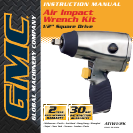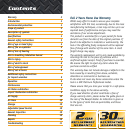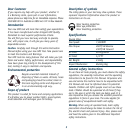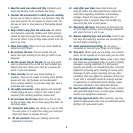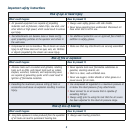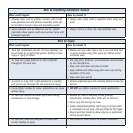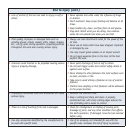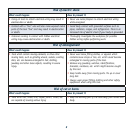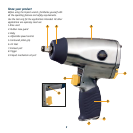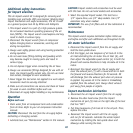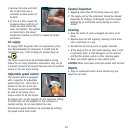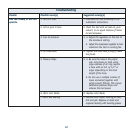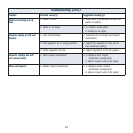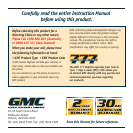4
1. Keep the work area clean and tidy. Cluttered work
areas and benches invite accidents and injury.
2. Consider the environment in which you are working.
Do not use air tools in damp or wet locations. Keep the
work area well lit. Do not expose air tools to rain. Do
not use air tools in the presence of flammable liquids
or gases.
3. Keep visitors away from the work area. All visitors
and onlookers, especially children and infirm persons,
should be kept well away from where you are working.
Do not let others in the vicinity make contact with the
tool or air hose.
4. Store tools safely. When not in use, tools should be
locked up out of reach.
5. Do not force the tool. The tool will do the job
better and safer working at the rate for which it was
designed.
6. Use the correct tool for the job. Do not force small
tools or attachments to do the job best handled by a
heavier duty tool. Never use a tool for a purpose for
which it was not intended.
7. Dress correctly. Do not wear loose clothing or
jewellery. They can be caught in moving parts. Rubber
gloves and non- slip footwear are recommended
when working outdoors. If you have long hair, wear a
protective hair covering.
8. Use safety accessories. Safety glasses and earmuffs
should always be worn. A face or dust mask is also
required if the sanding operation creates dust.
9. Do not abuse the air hose. Never carry the air tool
by the air hose. Keep the air hose away from heat, oil
and sharp edges.
10. Secure the work piece. Use clamps or a vice to hold
the work piece. It is safer than using your hand and
frees both hands to operate the tool.
11. Do not overreach. Keep your footing secure and
balanced at all times.
12. Look after your tools. Keep tools sharp and
clean for better and safer performance. Follow the
instructions regarding lubrication and accessory
changes. Inspect air hose periodically and, if
damaged, have it replaced. Keep tool handles dry,
clean and free from oil and grease.
13. Disconnect idle tools. Disconnect air tools from the
air hose before servicing, when changing accessories
and when the tool is not in use.
14. Remove adjusting keys and wrenches. Check to see
that keys and adjusting wrenches are removed from
the tool before switching on.
15. Avoid unintentional starting. Do not carry a
connected air tool with your finger on the trigger.
16. Stay alert. Watch what you are doing. Use common
sense. Do not operate an air tool when you are tired.
17. Check for damaged parts. Before using a tool, check
that there are no damaged parts. If a part is slightly
damaged, carefully determine if it will operate
properly and perform its intended function. Check for
alignment of moving parts, binding of moving parts,
breakage of parts, proper mounting and any other
conditions that may affect the operation of the tool.
A part that is damaged should be properly repaired
or replaced by an authorised service facility, unless
otherwise indicated in this Instruction Manual.
18. Guard against electric shock. Prevent body contact
with grounded objects such as water pipes, radiators,
cookers and refrigerator enclosures.
19. Use only approved parts. When servicing, use only
identical replacement parts. Use an authorised service
facility to fit replacement parts.



